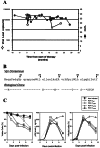Evidence for a cytopathogenicity determinant in HIV-1 Vpr
- PMID: 12093916
- PMCID: PMC123170
- DOI: 10.1073/pnas.142313699
Evidence for a cytopathogenicity determinant in HIV-1 Vpr
Abstract
HIV-1 is cytopathic for CD4(+) T lymphocytes in vitro and this property of HIV-1 is generally considered to account for some of its in vivo cytopathogenicity. Thus, the extent of lymphocyte depletion correlates with the level of viremia whereas low levels of viral replication are typically associated with stable lymphocyte levels and asymptomatic infection such as is observed in non-progressors. Here, we describe a non-progressor who did not fit this general pattern in that CD4(+) T lymphocyte homeostasis was maintained in the face of high-level viral replication. Biological viral isolates from this patient replicated in primary lymphocytes without inducing cytopathicity. Because this phenotype is reminiscent of Vpr-deleted viruses, we examined the contribution of the Vpr gene to the viral phenotype. Vpr alleles derived from this patient contained both premature stop codons and an unusual Q3R polymorphism. Insertion of patient-derived Vpr alleles or a Q3R substitution into a cytopathic HIV-1 clone resulted in a marked impairment of cytopathicity without affecting viral replication efficiency. The effect of Vpr on cytopathicity was unrelated to reported activities of Vpr including virion association, interaction with uracil DNA glycosylase, G(2) arrest, or enhancement of macrophage infection but correlated with the ability of Vpr to induce host cell apoptosis. This study suggests the presence of a determinant of in vivo cytopathogenicity within HIV-1 Vpr and further indicates that viral replication can be uncoupled from cytopathicity in vitro and in vivo.
Figures




Similar articles
-
Vpr cytopathicity independent of G2/M cell cycle arrest in human immunodeficiency virus type 1-infected CD4+ T cells.J Virol. 2007 Sep;81(17):8878-90. doi: 10.1128/JVI.00122-07. Epub 2007 Jun 6. J Virol. 2007. PMID: 17553871 Free PMC article.
-
Human immunodeficiency virus type 1 Vpr induces DNA replication stress in vitro and in vivo.J Virol. 2006 Nov;80(21):10407-18. doi: 10.1128/JVI.01212-06. Epub 2006 Sep 6. J Virol. 2006. PMID: 16956949 Free PMC article.
-
Effect of R77Q, R77A and R80A changes in Vpr on HIV-1 replication and CD4 T cell depletion in human lymphoid tissue ex vivo.AIDS. 2006 Apr 4;20(6):831-6. doi: 10.1097/01.aids.0000218546.31716.7f. AIDS. 2006. PMID: 16549966
-
Could Nef and Vpr proteins contribute to disease progression by promoting depletion of bystander cells and prolonged survival of HIV-infected cells?Biochem Biophys Res Commun. 2000 Jan 27;267(3):677-85. doi: 10.1006/bbrc.1999.1708. Biochem Biophys Res Commun. 2000. PMID: 10673351 Review.
-
HIV-1 Vpr: genetic diversity and functional features from the perspective of structure.DNA Cell Biol. 2004 Apr;23(4):207-22. doi: 10.1089/104454904773819798. DNA Cell Biol. 2004. PMID: 15142378 Review.
Cited by
-
The progestin-only contraceptive medroxyprogesterone acetate, but not norethisterone acetate, enhances HIV-1 Vpr-mediated apoptosis in human CD4+ T cells through the glucocorticoid receptor.PLoS One. 2013 May 3;8(5):e62895. doi: 10.1371/journal.pone.0062895. Print 2013. PLoS One. 2013. PMID: 23658782 Free PMC article.
-
Tat-induced FOXO3a is a key mediator of apoptosis in HIV-1-infected human CD4+ T lymphocytes.J Immunol. 2008 Dec 15;181(12):8460-77. doi: 10.4049/jimmunol.181.12.8460. J Immunol. 2008. PMID: 19050264 Free PMC article.
-
Evidence for Vpr-dependent HIV-1 replication in human CD4+ CEM.NKR T-cells.Retrovirology. 2012 Nov 7;9:93. doi: 10.1186/1742-4690-9-93. Retrovirology. 2012. PMID: 23134572 Free PMC article.
-
Mitochondrial dysfunction in lyssavirus-induced apoptosis.J Virol. 2008 May;82(10):4774-84. doi: 10.1128/JVI.02651-07. Epub 2008 Mar 5. J Virol. 2008. PMID: 18321977 Free PMC article.
-
A comprehensive analysis of the naturally occurring polymorphisms in HIV-1 Vpr: potential impact on CTL epitopes.Virol J. 2008 Aug 23;5:99. doi: 10.1186/1743-422X-5-99. Virol J. 2008. PMID: 18721481 Free PMC article.
References
-
- Mellors J W, Munoz A, Giorgi J V, Margolick J B, Tassoni C J, Gupta P, Kingsley L A, Todd J A, Saah A J, Detels R, et al. Ann Intern Med. 1997;126:946–954. - PubMed
-
- McCune J M. Nature (London) 2001;410:974–979. - PubMed
-
- Lifson J D, Feinberg M D, Reynes G R, Rabin L, Banapour B, Chakrabarti B S, Moss B, Wong-Staal F, Steimer K S, Engleman E G. Nature (London) 1986;323:725–728. - PubMed
Publication types
MeSH terms
Substances
Grants and funding
LinkOut - more resources
Full Text Sources
Other Literature Sources
Research Materials

